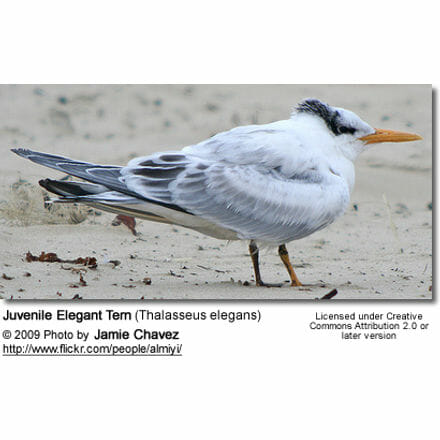Royal Elegant Terns
The Elegant Terns (Thalasseus elegans, syn. Sterna elegans – see Bridge et al., 2005) is a seabird of the tern family Sternidae.
Distribution / Range
It breeds on the Pacific coasts of the southern USA and Mexico and winters south to Peru, Ecuador and Chile.
Surprisingly, this Pacific species has wandered to western Europe as a rare vagrant on a number of occasions, and has interbred with the Sandwich Tern in France; there is also one record from Cape Town, South Africa in January 2006, the first record for Africa.

Nesting / Breeding
This species breeds in very dense colonies on coasts and islands, and exceptionally inland on suitable large freshwater lakes close to the coast.
It nests in a ground scrape and lays one to two eggs.
Unlike some of the smaller white terns, it is not very aggressive toward potential predators, relying on the sheer density of the nests (often only 20-30cm apart) and nesting close to other more aggressive species such as Heermann’s Gulls to avoid predation.
Diet / Feeding
The Elegant Tern feeds by plunge-diving for fish, almost invariably from the sea, like most Thalasseus terns. It usually dives directly, and not from the “stepped-hover” favoured by the Arctic Tern. The offering of fish by the male to the female is part of the courtship display.

Identification
This is a medium-large tern, with a long, slender orange bill, pale grey upperparts and white underparts. Its legs are black. In winter, the forehead becomes white. Juvenile Elegant Terns have a scalier pale grey back. The call is a characteristic loud grating noise like a Sandwich Tern.
This bird could be confused with the Royal Tern, but the latter species is larger and thicker-billed and shows more white on the forehead in winter. Out of range, it can also be easily confused with the Lesser Crested Tern. See also Orange-billed tern, and the external link below.
Some useful points to separate it from other terns in this group:
- It is marginally paler above than the Lesser Crested Tern with a white (not grey) rump.
- It a slightly longer, more slender bill and the curve of the bill is different to Lesser Crested tern.
- The black of the crest the comes down from the crown extends through the eye, creating a small black “smudge” in front of the eye. On Royal Tern, the black crest stops at the eye.
- The crest is more shaggy than in Lesser Crested Tern.





